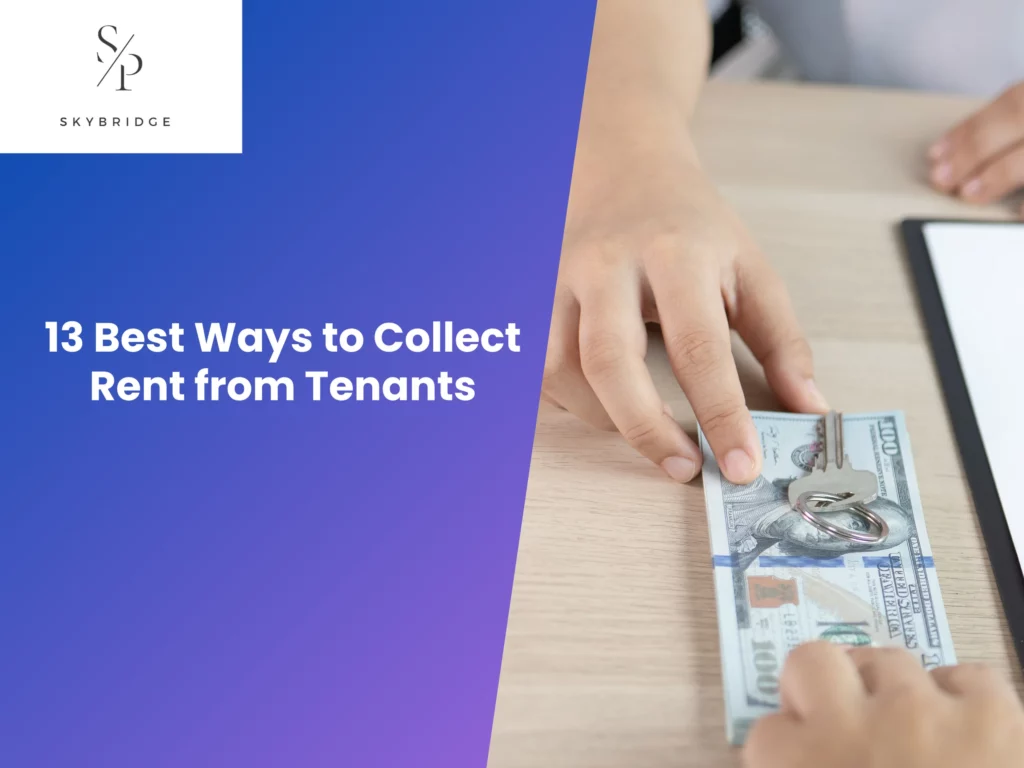The best ways to collect rent from tenants include using online payment platforms like Zelle, PayPal, or Venmo, direct deposit or ACH transfers for recurring withdrawals, and property management software that automates reminders and keeps detailed records. For traditional setups, money orders or a cashier’s check provide a verifiable record of payment and reduce disputes.
Choosing the right payment method depends on your property size, tenant base, and preferred tracking system. Online rent collection helps landlords receive funds on or before the due date, improving cash flow and eliminating manual errors. Traditional rental property payments remain practical for tenants without digital access, though they require additional oversight. This guide explains 13 practical payment options, from online methods and software to traditional methods, to help landlords maintain consistent, transparent, and efficient rent collection while strengthening tenant reliability.

1. Tenant Portals to Collect Rent from Tenants
Tenant portals are secure online login systems that let renters access lease details, submit maintenance requests, and communicate directly with property managers from one central dashboard. Through these portals, tenants can pay rent, submit maintenance requests, and view their account balances or payment history, while every transaction is automatically recorded for accuracy and transparency.
These portals also come with automated due date reminders and real-time tracking, reducing missed payments while improving communication. Using tenant portals simplifies the process of collecting rent online, offering transparency, convenience, and faster rent reconciliation within a single digital environment.
2. ACH Transfers to Collect Rent from Tenants
Automated Clearing House (ACH) transfers are electronic rent payments made directly between bank accounts, allowing landlords to receive rent automatically each month. Governed by the National Automated Clearing House Association (NACHA), these transfers follow standardized regulations that ensure smooth and secure processing. Tenants can schedule recurring payments using eCheck or auto debit through their bank or property management platform.
With low fees, consistent delivery, and built-in tracking, ACH transfers eliminate manual collection, reduce administrative work, and simplify property accounting for landlords managing multiple units. Due to these flexible and practical advantages, 64.8% of tenants use ACH as their preferred digital payment method (Source: Baselane).
3. Credit Card Payments to Collect Rent from Tenants
Some tenants prefer to pay rent using credit or debit cards through verified property management systems. This option allows immediate processing and helps tenants manage cash flow or earn reward points. Transactions are recorded automatically, giving landlords instant confirmation of payments.
As noted by Industry Dive, around 22.4% of tenants use credit or debit cards on digital rent platforms. However, these payments incur higher costs, typically 2.5% to 3.5% per transaction, so landlords should evaluate whether to absorb or pass on the fees. When used strategically, credit card payments enhance convenience, accessibility, and on-time submissions before the due date.
4. Mobile Rent Payments to Collect Rent from Tenants
Mobile rent apps like Venmo, Zelle, and PayPal allow tenants to send payments directly from their smartphones. These platforms provide fast transfers, automated receipts, and seamless integration with accounting or property management software. Tenants can schedule or automate payments, reducing late submissions and manual follow-ups.
For landlords, mobile payments create a convenient and transparent rent cycle. While Baselane reports that only 17% of landlords currently accept app payments, adoption is expected to rise due to the growing preference for mobile-friendly, flexible payment systems.
5. Secure Transaction Platforms to Collect Rent from Tenants
Secure payment platforms use encryption and fraud protection to safeguard every transaction. These systems comply with PCI standards, ensuring that tenant financial data remains confidential throughout the payment process. Multi-layer verification helps detect suspicious activity, minimizing risks of unauthorized access or duplicated transfers.
Adopting secure systems builds tenant trust and prevents disputes related to failed payments. For landlords managing several online rent collection accounts, such platforms offer reliability, transparency, and peace of mind across every digital transaction.
6. Landlord Studio to Collect Rent from Tenants
An all-in-one property management platform, Landlord Studio helps landlords streamline rent collection, track expenses, and stay connected with tenants through a single, intuitive dashboard. The tenant app enables secure online payments, while the payment dashboard provides full visibility into every transaction.
In addition to rent collection, Landlord Studio includes advanced fraud detection, preventing illegal transactions, accounting tools, and financial reporting to simplify bookkeeping. Balancing automation with control, it is ideal for small and mid-sized portfolios seeking efficiency without unnecessary complexity. The app holds a 4.8/5 rating on G2 and 4.9/5 on Software Advice, reflecting strong satisfaction among landlords.
7. Avail to Collect Rent from Tenants
Part of the realtor.com, Avail is designed for DIY landlords who prefer a simple yet automated rent collection process. The platform supports recurring rent payments, automatic reminders, and tenant screening, while also offering digital lease signing and maintenance tracking.
Automation features help reduce missed payments and keep communication clear between landlords and tenants. Avail is a great fit for independent property owners who need an affordable, flexible tool for electronic rent collection. It currently holds a 4.8/5 rating on G2 and 4.6/5 on Software Advice, demonstrating its popularity among self-managing landlords.
8. DoorLoop to Collect Rent from Tenants
DoorLoop combines rent collection, accounting, and tenant communication in one integrated system. It automatically syncs transactions, sends payment alerts, and supports tenant messaging to maintain clear communication.
The platform includes CRM and reporting features, making it ideal for landlords or property managers overseeing large portfolios. DoorLoop helps simplify accounting, manage payments, and maintain consistent records for every property. This software is rated 4.8/5 across both G2 and Software Advice, showing strong approval from users who prioritize comprehensive management features.
9. Buildium to Collect Rent from Tenants
Designed for professional landlords and HOA managers, Buildium automates rent payments, lease tracking, and tenant communication within a secure online portal. The system can automatically apply late fees and manage multi-unit properties, helping property managers stay organized across large portfolios.
Comprehensive accounting and reporting tools make it easier to monitor income, expenses, and cash flow in real time. Buildium is ideal for property managers seeking a scalable and dependable platform for collecting rent payments online. It holds a 4.4/5 rating on G2 from 249 users and a 4.5/5 rating on Software Advice from over 2,100 reviews, indicating consistent user satisfaction across larger operations.
10. PayRent to Collect Rent from Tenants
Created to make rent collection simple and virtual, PayRent offers a secure, fee-free payment system with instant deposit capabilities and tenant control settings. Renters can schedule flexible payment dates, while landlords receive instant notifications once deposits are completed.
The platform emphasizes security through strong encryption and fraud protection tools, ensuring safe financial transactions. PayRent is best suited for landlords who value ease, transparency, and cost-efficiency while managing rental property payments with no added transaction fees.
11. In-Person Rent Collection from Tenants
In-person rent collection involves meeting tenants directly to receive payments by cash or check. This method allows personal interaction, relationship building, and immediate confirmation that rent has been paid. Some landlords continue using it for smaller properties, single-family homes, or older tenants who are less comfortable with digital tools.
However, in-person collection requires significant manual effort and scheduling coordination, which can be difficult across multiple units. It also poses security risks when handling large amounts of cash. This method remains viable only when close proximity and trust between landlord and tenant are already established.
12. Mail-in Rent Checks Collection from Tenants
Many tenants still send rent checks by mail, especially when digital systems are unavailable or inconvenient. Once received, landlords must deposit these checks manually or through mobile banking apps. Although mailing allows a paper trail, it often leads to postal delays and uncertainty about the payment’s arrival date.
Tracking becomes an issue if a check is lost or delayed, and reconciling multiple mailed payments can be time-consuming. To manage these risks, landlords should request postmarked envelopes, issue receipts upon deposit, and encourage early mailing before rent is due. While functional, this method lacks the efficiency of automated systems.
13. Cash Payments to Collect Rent from Tenants
Some tenants still prefer to pay rent in cash, particularly when they lack bank accounts or prefer tangible transactions. While cash payments provide immediate confirmation, they are untraceable and unsafe without proper documentation. Losing cash or handling it without receipts can cause disputes and complicate accounting.
Landlords who accept cash should always issue a dated, signed receipt and record the transaction in a payment log. Storing or transporting cash introduces additional risk, making it unsuitable for larger portfolios. Cash collection should only be used in limited situations where trust and convenience outweigh the safety concerns.
How do Landlords Collect Rent Online from Tenants?
Common online payment methods landlords can use to collect rent online include tenant portals, ACH transfers, credit card payments, mobile rent apps, and secure transaction platforms. A report from TenantCloud revealed that online rent payments now account for 81.7% of all transactions, up from 78.4% the previous year, showing the growing demand for online rent collection among both landlords and tenants. The reason for this growth is due to its quick deposits, digital receipts, and automated due date reminders.
How to Keep Track of Rent Payments?
Landlords can keep track of rent payments by using property management software or online rent collection tools like Landlord Studio, Buildium, or DoorLoop that automatically record each transaction. For traditional methods, maintaining a rent ledger, issuing receipts, and reconciling payments monthly helps prevent errors. Automated systems are more reliable because they create digital records, generate reminders, and reduce the risk of missed or late payments.
What are the Modern Methods for Rent Payments?
Modern rent payment methods include online transfers, tenant portals, ACH payments, mobile rent apps, and credit or debit card transactions. These options allow tenants to pay rent securely and landlords to receive funds directly into their accounts. Many landlords now use platforms like Zelle, PayPal, Venmo, or property management systems that integrate accounting and reporting. These modern solutions improve transparency, speed, and convenience, eliminating manual tracking and delays common with checks or cash.
What are the Best Rent Collection Tools and Software?
The best rent collection tools and software for landlords include Landlord Studio, Avail, DoorLoop, Buildium, and PayRent. Each platform supports automated rent reminders, digital payments, and real-time reporting to help landlords manage rent collection efficiently. For smaller portfolios, Avail and Landlord Studio offer simple, low-cost automation, while Buildium and DoorLoop suit property managers handling multiple units. PayRent is a strong choice for landlords seeking fee-free rent payments with fast deposits and built-in security.
Choose Local Property Management Company for Efficient Rent Collection
Many landlords face recurring challenges such as delayed payments, tracking errors, and limited communication with tenants. Managing rent manually or across multiple systems often leads to missed due dates, inconsistent reporting, and unnecessary stress. Partnering with a local property management company helps eliminate these issues by centralizing payment collection, improving transparency, and ensuring every transaction is recorded accurately.
A local team familiar with the SoCal market understands area-specific rental trends, tenant expectations, and local regulations that affect payment timing and compliance. By using automation, professional property managers handle rent reminders, digital deposits, and accounting reports without the risk of human error.
Outsourcing rent collection allows landlords to focus on growth while experts manage tenant communication, deposits, and late-fee enforcement. For property owners across Los Angeles, Orange County, and nearby areas, working with an experienced property management company ensures timely, organized, and stress-free rent collection from every tenant.







